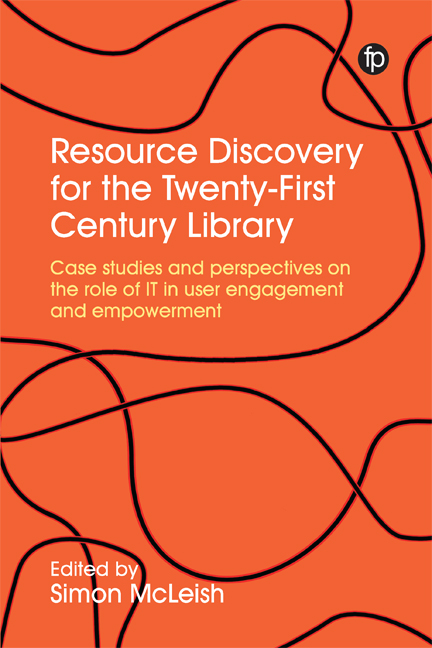Book contents
- Frontmatter
- Contents
- Figures and Tables
- Contributors
- Foreword: Library Discovery Directions
- 1 Introduction: Technology and Resource Discovery
- 2 Flipping the Catalogue: Taking Resource Discovery to the Next Level
- 3 Breaking the Record: Liberating Data into Knowledge at the National Library Board of Singapore
- 4 Case Study: Clearing Library Discovery-to-Access Pathways for IEEE Content
- 5 Case Study: Putting Discovery at the Heart of the Library Experience
- 6 Investigating Resource Discovery Needs at the University of Oxford
- 7 ‘Why Can’t you Just Use Google?’
- 8 Exposing Collections and Resources Effectively
- 9 Open Source Discovery using Blacklight at the University of Hull
- 10 A World of Curated Knowledge: Leveraging the Wider Semantic Web to Enhance Library Discovery
- 11 Cultural Discovery: Trends and Futures
- 12 Discovering the Future
- Editorial Afterword
- Index
8 - Exposing Collections and Resources Effectively
Published online by Cambridge University Press: 23 July 2020
- Frontmatter
- Contents
- Figures and Tables
- Contributors
- Foreword: Library Discovery Directions
- 1 Introduction: Technology and Resource Discovery
- 2 Flipping the Catalogue: Taking Resource Discovery to the Next Level
- 3 Breaking the Record: Liberating Data into Knowledge at the National Library Board of Singapore
- 4 Case Study: Clearing Library Discovery-to-Access Pathways for IEEE Content
- 5 Case Study: Putting Discovery at the Heart of the Library Experience
- 6 Investigating Resource Discovery Needs at the University of Oxford
- 7 ‘Why Can’t you Just Use Google?’
- 8 Exposing Collections and Resources Effectively
- 9 Open Source Discovery using Blacklight at the University of Hull
- 10 A World of Curated Knowledge: Leveraging the Wider Semantic Web to Enhance Library Discovery
- 11 Cultural Discovery: Trends and Futures
- 12 Discovering the Future
- Editorial Afterword
- Index
Summary
Introduction: why should you care?
It is almost traditional to quote Ranganathan's Laws in any discussion of libraries, but his summaries of the purpose of libraries remain incredibly relevant. He suggested that ‘books are for use’ (Ranganathan, 1931), but more generally, collections are for use, whatever their contents and whether they are held by libraries or museums. For collections to be useful, it is necessary to enable discovery of both the collections themselves and the contents within the collections. While the organisation of archives into collections is well understood by their curators and managers, it can be extremely opaque to potential users, because collections are frequently organised in ways which are connected to their acquisition (and may, therefore, be labelled with the name of the donor, rather than an informative title), and the researchers who have an interest in the collection generally do not care about acquisition but content and relevance to their work. This immediately suggests that libraries and museums need to do more than just list research collections by name.
While library holdings of books and journals (electronic or paper) are catalogued to well known standards, and can be found in library catalogues, discovery tools, publisher databases or Google Scholar without much difficulty, unique archival collections are harder to find, for a number of reasons:
lack of cataloguing standards historically and a heterogeneous range of material types with different descriptive needs (a Neolithic stone axe in a museum does not have a title, for instance): library discovery services are generally designed for bibliographic materials, so can work poorly when item descriptions do not easily fit into relevant standards, such as MARC
the need for individually crafted descriptions for unique items (as opposed to books and journals, where identical copies may already have been catalogued elsewhere to provide descriptions which can be copied, or where publishers also provide descriptive metadata)
incomplete descriptions, both per item and on a collection level (major archival collections may have kilometres of uncatalogued boxes of material): there is no hope of finding uncatalogued material except by asking the right person, and incomplete records lessen the chance of discovery through most if not all tools
- Type
- Chapter
- Information
- Resource Discovery for the Twenty-First Century Library , pp. 115 - 128Publisher: FacetPrint publication year: 2020



